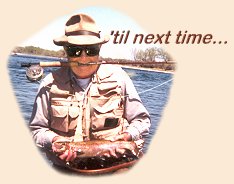From Claudia S.: I would like to ask you where are
most mayfly nymphs found in freshwater rivers, in
the middle or edges? Also is the middle of the river
faster than the edge? And if so will it have more
dissolved oxygen? And will this enable a greater
population of mayfly nymphs? Also is the depth of
the river greatest at the middle or edge? And does
the depth affect the velocity and number of mayfly nymphs?
Your help is much appreciated. Many thanks.
A.
Claudia, you've asked several questions having to do
with two general themes: (1) river channel shape and
form (geomorphology) and (2) distribution of mayfly
nymphs. I'll address your questions under these
themes and hope to answer your questions.
River channel geomorphology: A natural, meandering
river exhibits several characteristics pertaining to
depth, current velocity, and channel form. A line
connecting the deepest points along a river channel
is called the thalweg. Now this line can shift
back and forth as the channel meanders; where the
channel swings against a cut bank, the thalweg is
closer to the bank than to the middle of the channel.
In a straight section of the channel, the thalweg is
usually near the center of the channel. Thus, the
deepest part of the channel shifts back and forth
as the river meanders; it is deepest near the edge
on the outside of a curve, shallowest on the inside
of the curve, and deepest, usually, in the middle on
a straight reach. Current velocity is generally greatest
along the thalweg because there is less drag (friction)
of the entire water column against the bottom where it
is deepest. In most average size streams and rivers,
dissolved oxygen will not vary much from side to side;
the mixing of the water as it tumbles over rocks ensures
adequate exchange of oxygen with the air and within the
water column.
Mayfly nymph distribution: This is a little harder to
answer directly because the answers to your questions
can vary depending on the size of the river you are
talking about and the number of mayfly species indigenous
to the area. There are many types of rivers and over 700
different species of mayflies, so it is difficult to get
very specific. Mayfly nymph distribution across the width
of a stream or river can vary with the size of the river.
A small headwater stream or mid-size river can have a
fairly uniform distribution of rocks, pebbles, etc. from
edge to edge. Given these uniform conditions, it is
unlikely that the distribution of mayfly nymphs will be
much different, in either numbers or species or number
of individuals per unit area, across the bottom. However,
as rivers get bigger, several conditions may change across
the width of the river. Water current can be greater in
the middle, and the distribution of bottom materials can
change, thus presenting different habitat conditions in
different parts of the river. Thus, you might find a
situation where the faster current in the middle of a
river keeps the substrate cleared of sand and silt.
Here, then, you will find larger stones and rocks that
are suitable habitat for certain species. In the shallow
areas along the edges of the stream, sand and silt may
accumulate, thus providing habitat for those mayfly species
adapted to live in these conditions. Will there be more
mayfly nymphs in the middle or edges? This depends on
the species present, the relative amount of habitat
available (more rocks or more mud), and the available
food in each area. Different mayfly nymphs require
different kinds of foods, e.g., algae on rocks for the
grazers, suspended particulate matter for the filterers,
and deposited particulate matter for the collectors.
The combination of flow, light conditions, and input
of particulate organic matter dictates which types of
food are present and in what amounts. Mayfly nymphs
are sensitive to amounts of dissolved oxygen present
in the water, so this, too, will influence the numbers
that you find in different habitats.
I've only generalized for a couple of situations above;
to go into more detail would take an undue amount of space.
If you'd like to pursuer this further with more specific
questions, please feel free to contact me.
~ C. E. (Bert) Cushing, aka Streamdoctor
105 W. Cherokee Dr.
Estes Park, CO 80517
Phone: 970-577-1584
Email: streamdoctor@aol.com
 The 'Stream Doctor' is a retired professional stream ecologist and
author, now living in the West and spending way too much time
fly-fishing. You are invited to submit questions relating to
anything stream related directly to him for use in this Q & A Feature
at streamdoctor@aol.com.
The 'Stream Doctor' is a retired professional stream ecologist and
author, now living in the West and spending way too much time
fly-fishing. You are invited to submit questions relating to
anything stream related directly to him for use in this Q & A Feature
at streamdoctor@aol.com.

 The 'Stream Doctor' is a retired professional stream ecologist and
author, now living in the West and spending way too much time
fly-fishing. You are invited to submit questions relating to
anything stream related directly to him for use in this Q & A Feature
at
The 'Stream Doctor' is a retired professional stream ecologist and
author, now living in the West and spending way too much time
fly-fishing. You are invited to submit questions relating to
anything stream related directly to him for use in this Q & A Feature
at